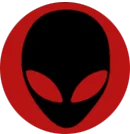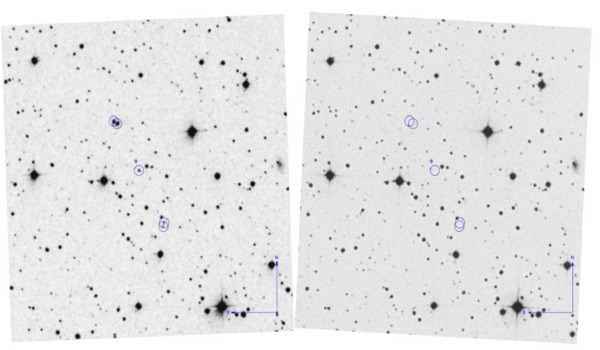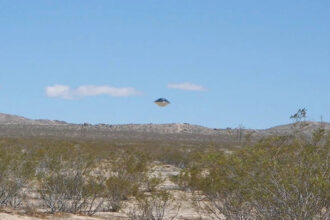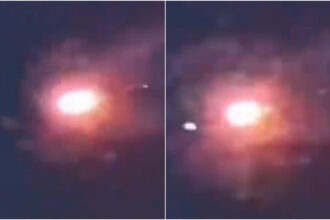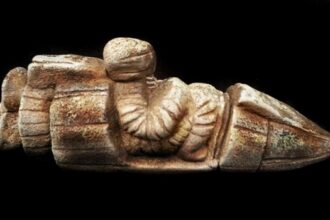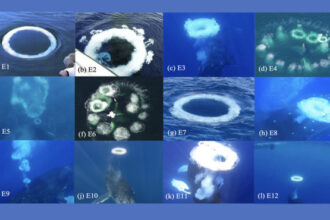On July 20, Swedish explorer Dennis Asberg, one of the leaders of the team of discoverers of the so-called Baltic Sea Anomaly, emerged from anonymity on X after posting a video claiming that soon, in partnership with his friend, the prominent and respected Swedish astronomer Beatriz Villarroel, they would reveal to the world something “so overwhelming, completely insane, and difficult to process that it perhaps should not even be disclosed to humanity.”
Asberg’s announcement drew attention, sparked debates, and also faced much criticism, leading him to delete the post.
But the doubt and expectation had already been set: after all, what could be so overwhelming that it might not be a good idea to disclose it to humanity?
Beatriz Villarroel is a Swedish astronomer of Spanish descent who has gained worldwide recognition for her innovative work and for challenging the boundaries of traditional astronomy. Daughter of a family marked by migration stories — one of her grandparents was one of the “war children” sent from Spain to the Soviet Union during the Spanish Civil War — Beatriz carries in her trajectory the spirit of someone seeking new frontiers, both in science and in understanding the universe.
Graduated in Physics and holding a PhD in Astronomy from Uppsala University in Sweden, where she defended a thesis on active galactic nuclei in 2017, she has built a career marked by boldness and interdisciplinarity. She is currently an assistant professor at the Nordic Institute for Theoretical Physics (NORDITA), affiliated with Stockholm University and the KTH Royal Institute of Technology. Before this, she worked at centers of excellence such as ETH Zurich and the Instituto de Astrofísica de Canarias in Spain.
What truly makes Beatriz a unique name in science are the projects she leads. One of them is VASCO — Vanishing & Appearing Sources during a Century of Observations — which compares images of the sky taken in different decades to identify stars and astronomical objects that have mysteriously disappeared. The project can reveal everything from extreme astrophysical phenomena, like stars that collapse directly into black holes, to signs of unknown technologies. VASCO incorporates citizen science, involving volunteers from various countries, including regions in Africa, making the search for answers a truly global effort.
Another bold project by Beatriz is EXOPROBE, which aims to investigate the possibility of the existence of alien probes in the Solar System. Using high-speed cameras and advanced scanning techniques, the goal is to search for artifacts that could indicate non-human technological activity near Earth.
Her work has earned her significant awards, such as the L’Oréal-UNESCO For Women in Science in Sweden in 2021 and international recognition as one of the 15 International Rising Talents in 2022. In 2023, she received the Heterodox Academy Courage Award for her intellectual bravery and commitment to open science.
Besides research, Beatriz has stood out as a science communicator. In a TEDx event in Zurich, she advocated the importance of searching for alien artifacts without prejudice and based on the scientific method. She also presented her ideas at the Sol Foundation in Stanford, showcasing her projects as examples of how astronomy can embrace new questions without fear of the unknown.
Thus, with an astronomer of this caliber behind the announcement, speculations quickly arose and proved accurate: the revelation would be that possible techno-signatures — signals or evidence indicating the presence of non-human technology — had been recorded or discovered in Earth’s orbit.
On social media, many even used the term “alien probes” monitoring Earth at some stage of our existence.

Two Articles Released: ‘The Transients‘
In fact, two articles were published by astronomer Beatriz Villarroel following the announcement made by the lead researcher of the Baltic Sea Anomaly project.
It is worth noting that both are preprints and still need to undergo rigorous peer review, as Villarroel herself emphasized in a post on her X account:
“The two articles I published are preprints — that is, they are under peer review. Each result will now be rigorously examined for observational biases or systematic effects. If the signals are confirmed, they could reshape the way we see the sky.”
On July 25, in collaboration with astronomer Stephen Bruehl, Beatriz released an article exploring the statistical relationship and identifying a possible connection between transients (phenomena that appear and disappear in the sky over short periods of time) from the pre-Sputnik era — before the launch of the first artificial satellite by the former Soviet Union —, atomic bomb tests, and historical UFO sightings.
The study analyzed sky images taken between 1949 and 1957 by the Palomar Observatory, a period marked by intense nuclear activity in the United States, the Soviet Union, and the United Kingdom. During the investigation, the scientists found that transients occurred 45% more frequently on or near days of atomic tests. A significant increase in these phenomena was also observed on dates that coincided with peaks in reports of unidentified flying objects.
These findings suggest that even before humanity had artificial objects in Earth’s orbit, some kind of non-natural technological activity appeared to be occurring in space. Furthermore, the transients showed a higher incidence during periods of nuclear weapons testing and coincided with historical UFO observation events on the planet.
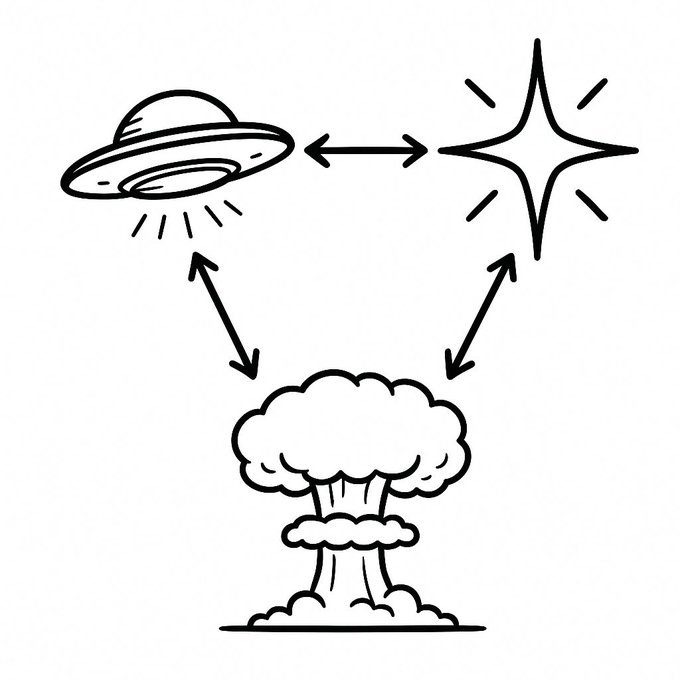
The ‘So-Called’ Article: Are Transients Really Technosignatures?
In the post made yesterday, the 27th, on her X account, accompanied by the second article, the astronomer emphasized:
“The key question has been: are the transients real or plate defects?”
According to her, as she also pointed out in the comment itself, these “flashes of light” that appear in astronomical observations are likely reflections of sunlight on “objects in space with highly reflective surfaces,” and not equipment errors. This may be more common than previously thought.
“This is a preprint of a paper now under review. We first tried in 2022, but it was too early for the journals. Years later, with better methods, we gave it another go. The key question has been: are the transients real, or plate defects? Well, there seems to be a clear deficit of transients in the Earth’s shadow. If correct, that demonstrates they’re highly reflective objects with flat surfaces (think mirrors, glass…) — and transients are sunlight glints. And it seems there may be a few more of them than we initially thought.”

What does the article say?
The article, titled “Aligned, multiple-transient events in the First Palomar Sky Survey,” investigates aligned transient events in digitized astronomical images from the First Palomar Sky Survey (POSS-I), taken before the satellite era. The main objective is to search for highly reflective artificial objects near Earth that could be responsible for these events.
The researchers apply a methodology proposed by Villarroel et al. (2022) and use a sample of transients from Solano et al. (2022). They look for multiple transients within a single plate exposure that, besides being point-like, are aligned along a narrow band. For this, they use POSS-I images and verify candidates with higher-resolution images from the SuperCOSMOS Sky Survey, discarding digitization artifacts or photographic plate defects. They also conduct a test in Earth’s shadow to check if the visibility of the transients depends on sunlight.
The study identifies several promising candidates of aligned transients, including one with a statistical significance of approximately 3.9. The authors note that known astrophysical or instrumental explanations do not fully account for these events. Interestingly, one of the high-significance candidates coincides temporally with the “UFO flyover” in Washington D.C. in 1952, and another occurs one day after the peak of the 1954 UFO wave. Although no direct causality is implied, these temporal correlations suggest the need for further investigation.
The authors explore the hypothesis that these events are caused by quick reflections of sunlight on highly reflective objects in geostationary orbit (GSO) or emissions from artificial sources above the Earth’s atmosphere. They find a highly significant deficit of transients within Earth’s shadow, supporting the interpretation that sunlight reflection plays a fundamental role in producing these events, strengthening the rejection of the photographic plate defect hypothesis.
The article also discusses the challenge of distinguishing between genuine transients and photographic plate defects, arguing that the simultaneous and aligned occurrence of transients is a strong signature of reflective orbital objects. The absence of known natural or instrumental causes, combined with spatial alignment, demands further investigation.
Finally, the study suggests that analyzing historical photographic survey data could reveal unknown transient phenomena and encourages more systematic searches in these datasets. It also mentions the development of artificial intelligence–based methods to filter transients resembling defects and to estimate the upper limit fraction of objects that could be non-terrestrial artifacts (NTAs). Simulations with different three-dimensional object shapes are also performed to understand the observed brightness patterns.
In summary, the article presents evidence of aligned transient events in historical astronomical data that cannot be easily explained by known natural or instrumental phenomena. It suggests that these events may be caused by sunlight reflections on artificial objects in orbit and highlights the need for further research, including statistical and AI methods, to investigate the nature of these phenomena, especially given the intriguing temporal correlations with historical UFO sightings.
In Simple Words
The article proposes that, if it is concluded that such records are not equipment errors, then we could be facing strong scientific evidence of non-human technological activity in Earth’s orbit.
This would indicate that they are technosignatures — artificial alien technologies.
As already suggested by other names in academic science, such as the well-known Harvard professor Avi Loeb, technological objects — such as spacecraft and “probes” from some other civilization in the universe — could be accompanying and monitoring our activities on Earth.
The correlation between nuclear tests and UFO sightings, reports, and recorded activity during the period in which these transients were captured reinforces something long speculated in the ufological field: the phenomenon’s interest in our actions, especially in sensitive areas such as military bases and nuclear power plants.
If confirmed, these observations could represent some of the most compelling evidence ever found that we are not alone and that advanced civilizations may be observing Earth, leaving detectable traces in historical astronomical data.
You can access the first article by clicking here and the second article by clicking here.
For anyone interested in learning more about the adventures of astronomer Beatriz Villarroel in this unconventional academic universe:
Here’s her TEDx Talk from two years ago about the search for alien life:
You can watch her interview with Matt Ford on his Good Trouble Show here:
She did an interview with Ross Coulthart here:
And one with Jesse Michels here:
Here’s a talk she gave as part of the Sol Symposium in November 2024:
Here’s her presentation at the 2023 SCU (Scientific Coalition for UAP):
And an update she gave following that talk:
Here’s an interview she gave for The DemystifySci Podcast:
Here’s coverage of her work from five years ago on Event Horizon:
For fun, here’s a Remote Viewing session about what Villarroel and Ansberg discovered:

